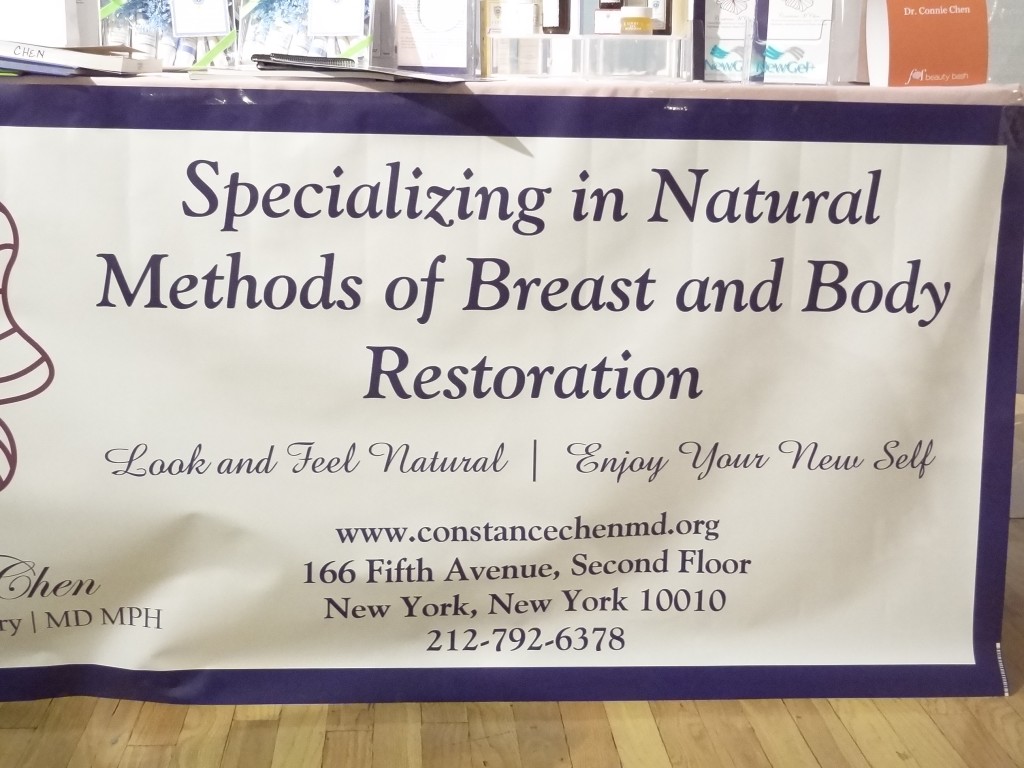Following yesterday’s post, I realize that each of us has our own priorities when it comes to our looks. I don’t wear shapewear to the gym, but I certainly color my hair.
There’s another feature I’ve become particularly vain about since beginning this blog: my full-on-top breasts. We’ve all been told that we’ll start to sag one day, and I think I might be fine with that, but I’m sad about the possibility of losing the plumpness that fills my bra cups to the very rim. Bra fitters and manufacturers have told me that there’s nothing a woman can do about that empty air that occurs between an elderly woman’s breast tissue and the top of her bra just below the straps, so I’ve been trying to appreciate what I have while I have it.
Then I saw the title of Dr. Constance Chen‘s presentation at the Fab over Fifty Beauty Bash, and I dared to hope for a solution: “Breast and Body Restoration: Doing It the Natural Way”.
I made a beeline toward her booth ahead of her speech and told her about my blog. Of course she assumed I would be interested in writing about breast reductions, something she’s very good at and that a lot of women want, but I explained that my readers and I have spent so much time learning to accept and value our breasts that we’d really like to know how we can keep them.
It turns out there’s an operation for that. It’s called a perforated flap breast reconstruction. Here’s how I understand it:
- Skin and fat is taken from your abdomen or bottom (basically, it’s a bonus tummy tuck if you want one).
- When the fat is removed, the microsurgeon also dissects out one artery and one vein, each no wider than 2mm.
- The skin and fat is transferred to your breasts, and the blood vessels are attached to matching blood vessels in your chest wall to restore blood flow to the transferred tissue.
What makes this procedure “natural” even though it involves surgery is the use of the patient’s own tissue instead of a foreign body (such as an implant). It differs from simply grafting your own tissue to your chest (after liposuction, for instance) because grafting doesn’t offer its own blood supply. This quote from her website explains the advantages:
By using the body’s own tissue, the restored breast is composed of soft, warm, living tissue, which integrates with your body over time. If you gain or lose weight, your breast will also gain or lose weight – just like any other part of your body. There is no chance of rejection, as there is with an artificial implant, as an autologous tissue breast reconstruction is composed of tissue that is already a part of you.
…
In addition, it may be possible to connect the nerves to give sensation to the reconstructed breast. Finally, it may be possible to transfer lymph nodes into the armpit to treat post-mastectomy upper extremity lymphedema.
Another advantage of this method is that it doesn’t use any muscle so there is far less pain or chance of abdominal complications.
While this procedure is often combined with a breast lift or reduction, its main benefit is for women who have lost one or both breasts to cancer. I felt sheepish asking questions for my own vain purposes, but I also felt excited about the possibilities for those of us who may have to face reconstruction in the future or know someone facing it. Only a handful of surgeons currently perform this procedure, and if I were a woman in need of reconstruction, I would want to know one of them. That’s why I’m introducing you to Dr. Chen.

Something non-invasive to consider is weight lifting. Weightlifting really changed my posture as I learned to engage my chest and back muscles. We computer-users can easily have crummy posture,so it’s been pretty radical seeing how much better my breasts look and my clothes fit when I’m using really good posture.
This is really encouraging to hear, Karen. I’ve been trying to get into weightlifting, but I haven’t been consistent for a long enough time to see changes yet.
This reminds me of the episode of Sex and the City, when Samatha planned a breast augmentation using her ass fat.